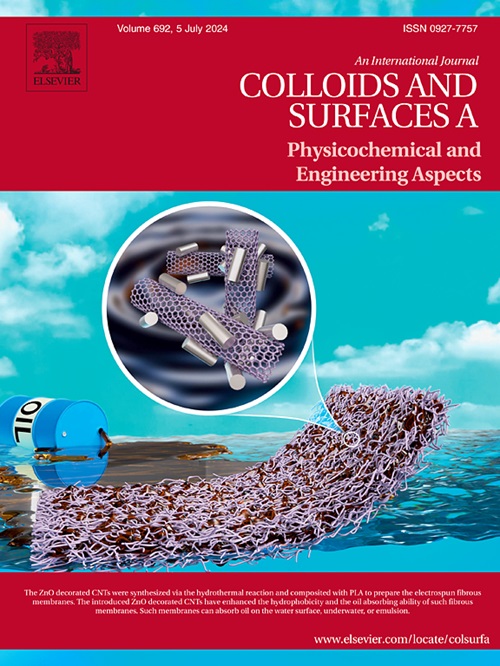Study of the wicking behavior of stretched elastic yarns under finite liquid droplets
IF 5.4
2区 化学
Q2 CHEMISTRY, PHYSICAL
Colloids and Surfaces A: Physicochemical and Engineering Aspects
Pub Date : 2025-07-17
DOI:10.1016/j.colsurfa.2025.137783
引用次数: 0
Abstract
The liquid water transport performance of fabrics is a critical factor in maintaining thermal and moisture comfort for the human body. Subjected to various dynamic stresses, elastic sportswear exhibits a relatively complex structure. However, most existing studies on the wicking behavior of elastic yarns are conducted under infinite liquid supply conditions, which do not realistically reflect the finite perspiration conditions of the human body. Furthermore, there is a lack of systematic investigations into the wicking behavior of single yarns, plied yarns, and interlaced structures under varying stretching states. In this study, an experimental platform was developed to simulate human perspiration in the form of microdroplets, and the wicking performance of polyester elastic filaments, piled yarns, and plain-woven interlaced networks under various stretching states was systematically investigated. The results indicated that stretching reduced both the yarn diameter and average hydraulic diameter. Moderate stretching improved the wicking length of both single and plied yarns, although a peak value was observed. Increases in twist level and stretch both reduced the initial wicking rate of plied yarns, while a higher number of plies mitigated the negative effects of high twist and stretching. The wicking length of plied yarns was generally greater than that of single yarns, and a significant positive correlation was observed between them. Moreover, the Lucas–Washburn equation demonstrated strong applicability for predicting the initial wicking behavior (1 s) under finite droplet conditions, although its applicability range of average hydraulic diameter depended on droplet volume. Simulations using Ansys software also showed strong agreement with experimental results. A significant negative correlation was observed between wicking length (120 s) and average hydraulic diameter. In the woven network, liquid preferentially diffused rapidly along yarns under lower stretch and then penetrated from the interlacing points into yarns under higher stretch. As the stretch difference between warp and weft yarns increased, the transfer of liquid from highly stretched yarns to those with lower stretch was significantly reduced. Additionally, the wicking lengths of the warp and weft yarns were strongly correlated with the wicking lengths of their corresponding plied yarns. This study systematically elucidated the mechanisms by which stretching influences the wicking performance of polyester elastic yarns under finite droplet conditions. The wicking behaviors of single yarns, piled yarns and woven networks under various stretch states were correlated, thus advancing theoretical understanding of liquid transport at the yarn level in elastic sports textiles. In addition, a preliminary simulation method for yarn wicking behavior was developed, providing both experimental evidence and theoretical support to facilitate the development of yarn-network-based capillary models for predicting liquid transport performance in fabrics. These findings offer valuable insights for the structural optimization and functional design of high-performance elastic sportswear.
有限液滴作用下拉伸弹性纱的排芯性能研究
织物的液态水输送性能是保持人体热湿舒适性的关键因素。弹性运动服在各种动应力作用下,呈现出相对复杂的结构。然而,现有的弹性纱线排汗性能研究大多是在无限供液条件下进行的,不能真实反映人体有限排汗情况。此外,缺乏对不同拉伸状态下单根纱线、层纱和交织结构的排芯行为的系统研究。本研究建立了模拟人体汗液微滴形态的实验平台,系统研究了不同拉伸状态下聚酯弹性长丝、堆纱、平织交织网的排汗性能。结果表明,拉伸降低了纱线直径和平均水力直径。适度拉伸提高了单线和股线的排芯长度,尽管观察到一个峰值。捻度和拉伸度的增加都降低了层纱的初始排芯速率,而层数的增加则减轻了高捻度和拉伸度的负面影响。混纺纱的芯长普遍大于单纺纱的芯长,两者之间存在显著的正相关关系。此外,Lucas-Washburn方程对有限液滴条件下的初始排芯行为具有较强的适用性(1 s),尽管其平均水力直径的适用性范围取决于液滴体积。Ansys软件仿真结果与实验结果吻合较好。排芯长度(120 s)与平均水力直径呈显著负相关。在织物网络中,液体优先沿低伸度纱线快速扩散,然后从交织点渗透到高伸度纱线中。随着经纬纱拉伸差的增大,液体从高拉伸纱向低拉伸纱的转移明显减少。经纱和纬纱的排芯长度与其对应的合股纱的排芯长度密切相关。本研究系统地阐明了有限液滴条件下拉伸对涤纶弹性纱排芯性能的影响机理。研究了不同拉伸状态下单纱、成纱和编织网的排芯行为,从而对弹性运动纺织品中纱线层面的液体输送进行了理论认识。此外,本文还开发了一种纱线排汗行为的初步模拟方法,为基于纱线网络的毛细模型的开发提供了实验证据和理论支持,以预测织物中的液体传输性能。这些研究结果为高性能弹性运动服的结构优化和功能设计提供了有价值的见解。
本文章由计算机程序翻译,如有差异,请以英文原文为准。
求助全文
约1分钟内获得全文
求助全文
来源期刊
CiteScore
8.70
自引率
9.60%
发文量
2421
审稿时长
56 days
期刊介绍:
Colloids and Surfaces A: Physicochemical and Engineering Aspects is an international journal devoted to the science underlying applications of colloids and interfacial phenomena.
The journal aims at publishing high quality research papers featuring new materials or new insights into the role of colloid and interface science in (for example) food, energy, minerals processing, pharmaceuticals or the environment.

 求助内容:
求助内容: 应助结果提醒方式:
应助结果提醒方式:


